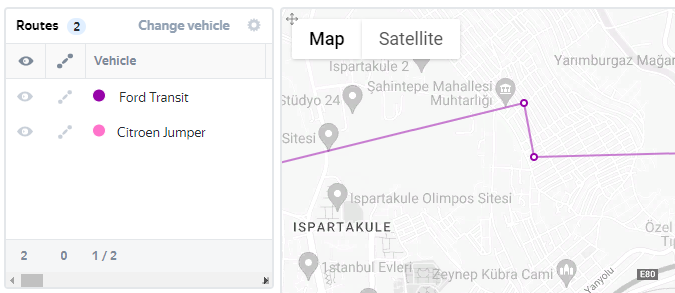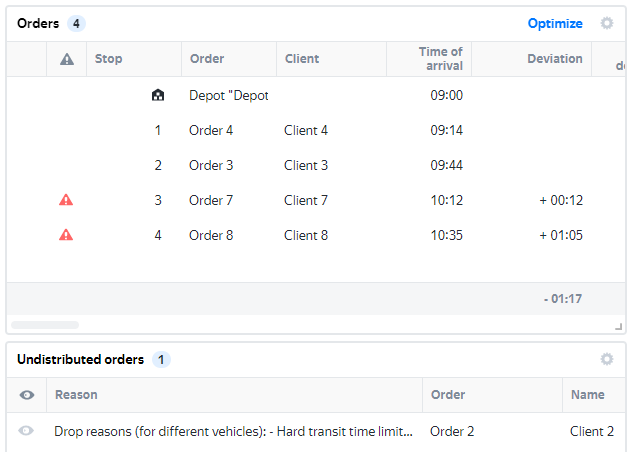Working with the resulting solution
When automatic routing is complete, you can view and edit the results in the Planning section.
Each solution has a unique task_id, which is given in the URL:
https://yandex.com/courier/companies/<company_id>/depots/all/mvrp/<task_id>
where company_id is the company ID.
To open the solution later, save the address from the browser address bar.
The resulting solution can also be viewed on mvrp-map.
Page elements
The page for working with the resulting solution has the following blocks:
- Control panel: General actions.
- Routes: Route metrics and final indicators.
- Orders and Undistributed orders: Orders that were included in the route and orders that couldn't be included.
- Map: A geographical representation of the routes and undistributed orders.

You can change the block layout:
- Set the block location
- Hover over the upper-left corner of the block, and click and drag the block to the desired location.
- Adjust the size
- Use the control element in the lower-right corner of the block.
- Change the column width
- To adjust the column width, move the borders of the column header.
- Adjust the column order and show or hide columns
-
Click
in the upper-right corner of the block.
- To adjust the column order, drag the column name to the desired position in the list.
- To hide a column, disable the option with the relevant name.
- To return to the standard settings, click Reset.
Control panel
- New planning
- Starts a new planning task. To avoid losing the current solution's results, save the
task_idbefore starting a new planning task. - Date
- The date that the solution is planned for.
- Search
- Use the search (
) to go to an object: select an order or a route from the drop-down list, and it will be highlighted in the blocks.
- Filter
-
Appears if the Vehicle tags option was used during planning.
The filter lists the values from the Vehicle properties field in the Routes table (equivalent to tags). To display routes that match specific vehicle properties, select the relevant value. You can select multiple values. As a result, data is filtered across all blocks.
- Export
- Used for exporting solutions.
Routes
Change vehicle: Assign a route to a different vehicle.
: Comments on the route. Hover over the icon to see the comments.
: Hide the route on the map. Clicking it in the table header will hide all routes.
: Switch the route display mode: simple straight lines or laid over roads. To enable this feature, contact technical support.


Orders and Undistributed orders
: Comments on the order. Hover over the icon to see the comments.
: Hide the undistributed order on the map. If you click the icon in the table header, all undistributed orders will be hidden.

Map
Map icons are explained below.
A number on a location represents its number in the sequence of route locations.
Show or hide the geofences set during planning using the Show geofences option in the upper-right corner of the map.
Map icons
: Depot,
depot.
: Cross-dock,
crossdock.
: Delivery,
delivery.
: Pickup,
pickup.
: Drop-off,
drop_off.
: A start or end location that isn't a depot,
garage.
: Breaks,
breaks.
: “Hotspot” for grouped routes.
: Undistributed order.
: A location that will be visited by several couriers. The number of colors represents the number of routes that intersect.
Viewing the solution
To go to an order or route, select the object on the map or in the table. The order or route that you select will be highlighted in all possible page blocks.
You can also use the Search field to switch to a specific object. Select an order or route in the drop-down list, and it will be highlighted in the blocks. The search is performed in the following fields:
- For orders (including unallocated orders)
-
- Number
- Name
- Address
- Recipient
- Comment
- Tags (mandatory and optional)
- Properties
- For couriers and vehicles
-
- Name
- Geofences (permitted and prohibited)
- Properties
The Cost with penalties (units) column is hidden by default and can be toggled in the table view settings.

If multiple routes have the same destination, they are marked with a multicolored circle on the map. The number of colors represents the number of routes that intersect. For example,  represents a location that will be visited by two couriers.
represents a location that will be visited by two couriers.
Click the icon in the route's row in the table to hide it from the map. To hide all routes except the highlighted route, click
in the table header.
Routes and orders can also be filtered by tag, provided they were set during planning. To do this, use the filter button on the control panel.
If there are comments for the route or order, the icon is displayed in the table row. Hover over it to see the comments.
To view the list of orders that are to be picked up from or delivered to a depot, click the arrow. The number of orders is indicated on the icon next to the depot name.

Totals for routes and orders are displayed in the tables' respective rows. For the Orders and Undistributed orders tables, you can also view interim totals for part of orders. To do this, select the desired rows while holding down Ctrl.

Editing a solution
You can change the planning result:
- Exclude an order from the route
- Drag the row from the Orders table to the Undistributed orders table.
- Include an unassigned order in the route
-
- Tables: click the route in the table or on the map. Drag the row from the Undistributed orders table to the Orders table.
- Map: drag the unassigned order's map icon to the row of the target route.
- Assign a route to another vehicle
-
Highlight the vehicle in the Routes table and click Change vehicle. In the window that opens, choose the vehicle.
If the original and selected vehicle have the same number of shifts, the order sequence is saved. Otherwise, the sequence can be optimized with a warning: “Shifts are different, the route can be rearranged when replacing the vehicle”.
- Move an order from one route to another
-
- Tables: drag an object from the Orders table to the Routes table in the row of the target route.
- Map: drag the order location to the necessary route row.
To drag multiple items at once, hold the Ctrl key and select them.
After each edit, the summary indicators are recalculated. Metric changes are displayed in the Routes table. If an indicator has improved compared to the initial planning result, the difference is highlighted green. If it has degraded, it's highlighted red.
Every time the results change, a new task_id solution ID is generated. Save the page address so you can resume work on the edited version later. When you edit the solution, the initial version doesn't change. It remains available via its link.